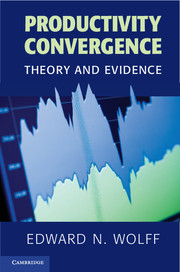Book contents
- Frontmatter
- Contents
- Acknowledgments
- 1 Introduction
- 2 An Overview of Modern Growth Theory
- 3 The Measurement and Estimation of Productivity Growth
- 4 Long-Term Record among the Advanced Industrial Countries
- 5 Postwar Record on Productivity Performance on the Aggregate Level among the Advanced Industrial Countries
- 6 Further Details on the Role of Education and Technology in the Productivity Performance among the Advanced Industrial Countries
- 7 Productivity Performance on the Industry Level among the Advanced Industrial Countries
- 8 The Productivity Slowdown
- 9 Postwar Economic Performance among Countries of the World
- 10 Recapitulation and Future Prospects for Growth
- Bibliography
- Index
3 - The Measurement and Estimation of Productivity Growth
Published online by Cambridge University Press: 05 June 2014
- Frontmatter
- Contents
- Acknowledgments
- 1 Introduction
- 2 An Overview of Modern Growth Theory
- 3 The Measurement and Estimation of Productivity Growth
- 4 Long-Term Record among the Advanced Industrial Countries
- 5 Postwar Record on Productivity Performance on the Aggregate Level among the Advanced Industrial Countries
- 6 Further Details on the Role of Education and Technology in the Productivity Performance among the Advanced Industrial Countries
- 7 Productivity Performance on the Industry Level among the Advanced Industrial Countries
- 8 The Productivity Slowdown
- 9 Postwar Economic Performance among Countries of the World
- 10 Recapitulation and Future Prospects for Growth
- Bibliography
- Index
Summary
Introduction
In the last chapter I presented an overview of modern growth theory and touched on some measurement and econometric issues. It is now helpful to provide technical details on both the measurement and the estimation of productivity growth, particularly total factor productivity (TFP) growth. In this chapter, I present the theoretical foundation for much of the empirical literature dealing with issues of productivity measurement.
As Erwin Diewert emphasized in a number of papers, TFP is a production function–based concept (see, for example, Diewert, 1976). Although all researchers would agree that productivity growth has occurred if a firm is able to produce more output from the same vector of inputs, the quantitative estimate of the magnitude of TFP growth depends on how each researcher chooses to measure it. There are several different ways to measure TFP – empirically based index numbers, econometric methods, stochastic frontier methods, and data envelopment analysis (DEA). It is important to address this issue, as well as many other important theoretical issues associated with defining and measuring productivity change. For instance, an uncritical reader might get the mistaken impression that there is such a thing as an industry-level or country-level production function and that it has the Cobb-Douglas functional form, because almost all empirical work in this literature uses this functional form.
- Type
- Chapter
- Information
- Productivity ConvergenceTheory and Evidence, pp. 70 - 123Publisher: Cambridge University PressPrint publication year: 2013



